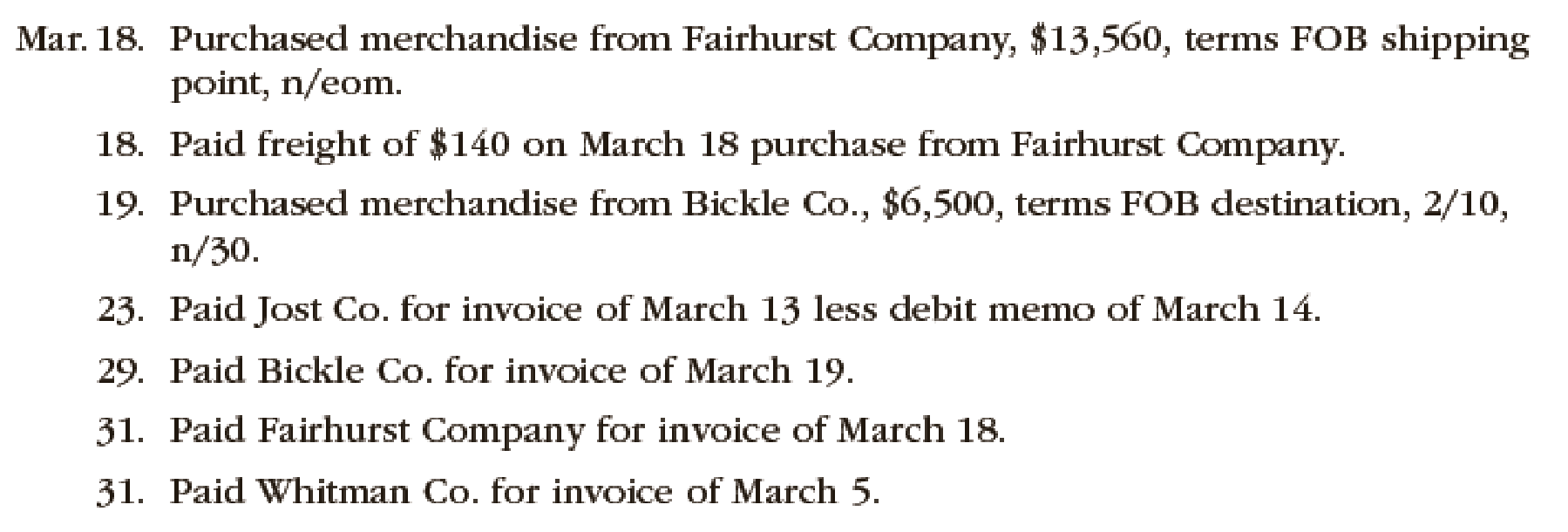
Concept explainers
The following selected transactions were completed by Niles Co. during March of the current year:


Instructions
Prepare journal entries to record the transactions of Company N during the month of March using perpetual inventory system.
Explanation of Solution
Perpetual Inventory System refers to the Merchandise Inventory system that maintains the detailed records of every Merchandise Inventory transactions related to purchases and sales on a continuous basis. It shows the exact on-hand-merchandise inventory at any point of time.
Journal entry: Journal is the book of original entry whereby all the financial transactions are recorded in chronological order. Under this method each transaction has two sides, debit side and credit side. Total amount of debit side must be equal to the total amount of credit side. In addition, it is the primary books of accounts for any entity to record the daily transactions and processed further till the presentation of the financial statements.
The following are the rules of debit and credit:
- 1. Increase in assets and expenses accounts are debited. Decrease in liabilities and stockholders’ equity accounts are debited.
- 2. Increase in liabilities, revenues, and stockholders’ equity accounts are credited. Decreases in all asset accounts are credited.
Record the journal entry of Company N.
| Date | Account Title and Explanation |
Post Ref. |
Debit ($) |
Credit ($) |
| March 1 | Merchandise Inventory | 43,035 | ||
| Accounts payable | 43,035 (1) | |||
| (To record purchase on account) |
Table (1)
- Merchandise Inventory is an asset and it is increased by $43,035. Therefore, debit Merchandise Inventory account with $43,035.
- Accounts payable is a liability and it is increased by $43,035. Therefore, credit accounts payable account with $43,035.
Working Note (1):
Calculate the amount of accounts payable.
Purchases = $43,250
Discount percentage = 2%
Freight charges = $650
Record the journal entry of Company N.
| Date | Account Title and Explanation |
Post Ref. |
Debit ($) |
Credit ($) |
| March 5 | Merchandise Inventory | 19,175 | ||
| Accounts payable | 19,175 | |||
| (To record purchase on account) |
Table (2)
- Merchandise Inventory is an asset and it is increased by $19,175. Therefore, debit Merchandise Inventory account with $19,175.
- Accounts payable is a liability and it is increased by $19,175. Therefore, credit accounts payable account with $19,175.
Record the journal entry of Company N.
| Date | Account Title and Explanation |
Post Ref. |
Debit ($) |
Credit ($) |
| March 10 | Accounts payable | 43,035 | ||
| Cash | 43,035 | |||
| (To record the payment against accounts payable) |
Table (3)
- Accounts payable is a liability and it is decreased by $43,035. Therefore, debit accounts payable account with $43,035.
- Cash is an asset and it is decreased by $43,035. Therefore, credit cash account with $43,035.
Record the journal entry of Company N.
| Date | Account Title and Explanation |
Post Ref. |
Debit ($) |
Credit ($) |
| March 13 | Merchandise Inventory | 15,239 | ||
| Accounts payable | 15,239 (2) | |||
| (To record purchase on account) |
Table (4)
- Merchandise Inventory is an asset and it is increased by $15,239. Therefore, debit Merchandise Inventory account with $15,239.
- Accounts payable is a liability and it is increased by $15,239. Therefore, credit accounts payable account with $15,239.
Working Note (2):
Calculate the amount of accounts payable.
Purchases = $15,550
Discount percentage = 2%
Record the journal entry of Company N.
| Date | Account Title and Explanation |
Post Ref. |
Debit ($) |
Credit ($) |
| March 14 | Accounts payable | 3,675 (3) | ||
| Merchandise Inventory | 3,675 | |||
| (To record purchase return) |
Table (5)
- Accounts payable is a liability and it is decreased by $3,675. Therefore, debit accounts payable account with $3,675.
- Merchandise Inventory is an asset and it is decreased by $3,675. Therefore, credit Merchandise Inventory account with $3,675.
Working Note (3):
Calculate the amount of accounts payable.
Purchases return = $3,750
Discount percentage = 2%
Record the journal entry of Company N.
| Date | Account Title and Explanation |
Post Ref. |
Debit ($) |
Credit ($) |
| March 18 | Merchandise Inventory | 13,560 | ||
| Accounts payable | 13,560 | |||
| (To record purchase on account) |
Table (6)
- Merchandise Inventory is an asset and it is increased by $13,560. Therefore, debit Merchandise Inventory account with $13,560.
- Accounts payable is a liability and it is increased by $13,560. Therefore, credit accounts payable account with $13,560.
Record the journal entry of Company N.
| Date | Account Title and Explanation |
Post Ref. |
Debit ($) |
Credit ($) |
| March 18 | Merchandise Inventory | 140 | ||
| Cash | 140 | |||
| (To record freight charges paid) |
Table (7)
- Merchandise Inventory is an asset and it is increased by $140. Therefore, debit Merchandise Inventory account with $140.
- Cash is an asset and it is decreased by $140. Therefore, credit cash account with $140.
Record the journal entry of Company N.
| Date | Account Title and Explanation |
Post Ref. |
Debit ($) |
Credit ($) |
| March 19 | Merchandise Inventory | 6,370 | ||
| Accounts payable | 6,370 (4) | |||
| (To record purchase on account) |
Table (8)
- Merchandise Inventory is an asset and it is increased by $6,370. Therefore, debit Merchandise Inventory account with $6,370.
- Accounts payable is a liability and it is increased by $6,370. Therefore, credit accounts payable account with $6,370.
Working Note (4):
Calculate the amount of accounts payable.
Purchases = $6,500
Discount percentage = 2%
Record the journal entry of Company N.
| Date | Account Title and Explanation |
Post Ref. |
Debit ($) |
Credit ($) |
| March 23 | Accounts payable | 11,564 (5) | ||
| Cash | 11,564 | |||
| (To record payment made in full settlement less discounts) |
Table (9)
- Accounts payable is a liability and it is decreased by $11,564. Therefore, debit accounts payable account with $11,564.
- Cash is an asset and it is decreased by $11,564. Therefore, credit cash account with $11,564.
Working Note (5):
Calculate the amount of net accounts payable.
Merchandise Inventory = $15,239 (2)
Purchase returns = $3,675 (3)
Record the journal entry of Company N.
| Date | Account Title and Explanation |
Post Ref. |
Debit ($) |
Credit ($) |
| March 29 | Accounts payable | 6,370 | ||
| Cash | 6,370 | |||
| (To record payment made in full settlement less discounts) |
Table (10)
- Accounts payable is a liability and it is decreased by $6,370. Therefore, debit accounts payable account with $6,370.
- Cash is an asset and it is decreased by $6,370. Therefore, credit cash account with $6,370.
Record the journal entry of Company N.
| Date | Account Title and Explanation |
Post Ref. |
Debit ($) |
Credit ($) |
| March 31 | Accounts payable | 13,560 | ||
| Cash | 13,560 | |||
| (To record payment made in full settlement less discounts) |
Table (11)
- Accounts payable is a liability and it is decreased by $13,560. Therefore, debit accounts payable account with $13,560.
- Cash is an asset and it is decreased by $13,560. Therefore, credit cash account with $13,560.
Record the journal entry of Company N.
| Date | Account Title and Explanation |
Post Ref. |
Debit ($) |
Credit ($) |
| March 31 | Accounts payable | 19,175 | ||
| Cash | 19,175 | |||
| (To record payment made in full settlement less discounts) |
Table (12)
- Accounts payable is a liability and it is decreased by $19,175. Therefore, debit accounts payable account with $19,175.
- Cash is an asset and it is decreased by $19,175. Therefore, credit cash account with $19,175.
Want to see more full solutions like this?
Chapter 6 Solutions
Financial Accounting
- I need help with this general accounting question using the proper accounting approach.arrow_forwardI am trying to find the accurate solution to this general accounting problem with appropriate explanations.arrow_forwardProvide solution without Ai if give answer copy past or Ai i give dislikearrow_forward
 College Accounting (Book Only): A Career ApproachAccountingISBN:9781337280570Author:Scott, Cathy J.Publisher:South-Western College Pub
College Accounting (Book Only): A Career ApproachAccountingISBN:9781337280570Author:Scott, Cathy J.Publisher:South-Western College Pub College Accounting, Chapters 1-27AccountingISBN:9781337794756Author:HEINTZ, James A.Publisher:Cengage Learning,
College Accounting, Chapters 1-27AccountingISBN:9781337794756Author:HEINTZ, James A.Publisher:Cengage Learning, Intermediate Accounting: Reporting And AnalysisAccountingISBN:9781337788281Author:James M. Wahlen, Jefferson P. Jones, Donald PagachPublisher:Cengage Learning
Intermediate Accounting: Reporting And AnalysisAccountingISBN:9781337788281Author:James M. Wahlen, Jefferson P. Jones, Donald PagachPublisher:Cengage Learning Financial And Managerial AccountingAccountingISBN:9781337902663Author:WARREN, Carl S.Publisher:Cengage Learning,
Financial And Managerial AccountingAccountingISBN:9781337902663Author:WARREN, Carl S.Publisher:Cengage Learning, Financial AccountingAccountingISBN:9781337272124Author:Carl Warren, James M. Reeve, Jonathan DuchacPublisher:Cengage LearningPrinciples of Accounting Volume 1AccountingISBN:9781947172685Author:OpenStaxPublisher:OpenStax College
Financial AccountingAccountingISBN:9781337272124Author:Carl Warren, James M. Reeve, Jonathan DuchacPublisher:Cengage LearningPrinciples of Accounting Volume 1AccountingISBN:9781947172685Author:OpenStaxPublisher:OpenStax College





